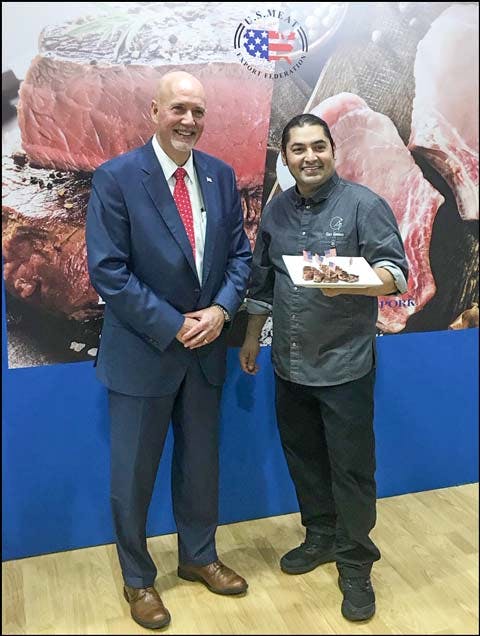Advantages of U.S. Beef, Pork Shared with International Crowd at SIAL Paris
Distinguishing U.S. beef and pork from competitors’ products around the world, USMEF participated in the Salon International de l’Alimentation (SIAL) show in Paris, France. Funded by the USDA Market Access Program (MAP), the Beef Checkoff Program and the National Pork Board, the effort at SIAL Paris included a USMEF booth where staff connected U.S. exporters with importers from Europe, China, Japan, Russia, the Middle East, South America, Ukraine, Africa and Southeast Asia for face-to-face business meetings.

Chef Jeroen Alexander Van Royen, one of the first graduates of USMEF’s beef ambassador training program in Europe, prepares U.S. beef and pork for a reception at SIAL Paris
USMEF also hosted a special meeting for importers and exporters of U.S. beef, providing them updates on the ongoing situation with the EU’s duty-free beef quota and sharing marketing plans for the region.
Nearly 160,000 visitors attended SIAL Paris, a show held every other year. More than 7,020 exhibitors from 105 countries were on hand to showcase products.
“SIAL Paris continues to be an event where companies from all over the globe look for new markets, launch new products and meet with others in the food export business to discuss the challenges and opportunities that lie ahead,” said USMEF President and CEO Dan Halstrom. “We were quite happy with the show this year, and our participating USMEF members agreed that things were very active from a business standpoint.”
One of the key themes this year was U.S. beef entering the EU under the duty-free high-quality beef quota. On Oct. 19, just days before the opening of SIAL Paris, the European Council – made up of representatives from the EU’s 28 member states – announced it had authorized the European Commission to negotiate with the United States on the functioning of the quota. The Commission requested the mandate in early September, suggesting that part of the existing 45,000 metric ton quota be allocated to the United States in a manner that is consistent with World Trade Organization (WTO) requirements.
USMEF took advantage of the timing of the announcement to invite EU importers of high-quality beef for the special meeting, where Halstrom gave a thorough overview of the situation.
“We’ve been in a situation the past two years where the duty-free quota has been fully utilized within the first few weeks of every quarter and, unfortunately, it’s been suppliers other than the U.S. that have increased their utilization of the quota, Uruguay, Argentina and Australia in particular,” said Halstrom. “USMEF has been working for some time with the U.S. government and the U.S. beef industry to address this issue. The negotiating mandate is an important step in the process and we’re optimistic that the ensuing negotiations will lead to changes in how the quota functions sometime in the first half of 2019. While it’s still not done, the general feeling at SIAL was pretty upbeat.”
Yuri Barutkin and Monty Brown, USMEF representatives in the EU, followed Halstrom by updating importers on USMEF’s marketing plans in the region.
“We continue to support the activities of importers and distributors of U.S. beef in their attempt to develop new customers and look for opportunities to grow the market,” Barutkin said. “While our main focus remains on HRI (hotel restaurant and institutional) business, we will actively support efforts for retail placement, both in supermarkets and online. Traditional markets of Western Europe remain the core of our marketing plans, with some activities planned for new markets that have a great deal of promise.”

Chef Alan Geaam, right, shows USDA-FAS Administrator Ken Isley one of the U.S. beef dishes
Beyond the buzz created by the news about the beef quota, SIAL Paris was an opportunity for USMEF to showcase U.S. red meat and learn about the competition.
Two chefs prepared U.S. beef and pork throughout the show for special meals served at meetings and receptions. Chef Alan Geaam cooked steaks and chops for breakfast and lunch, while chef Jeroen Alexander Van Royen – recently trained by USMEF as an ambassador for U.S. beef in Europe – catered receptions hosted by USMEF and its members.

SIAL Paris attracted a global crowd of more than 160,000 visitors and exhibitors from 105 countries
U.S. pork also attracted a great deal of interest during SIAL Paris, despite a surplus of pork in the EU in recent years.
“There is pork going to the EU, confined mostly to retail, but there is opportunity in the further processing sector in particular,” said Brown, who has closely monitored pork imports in Europe. “I think especially with the changes that are coming with Brexit, there is potential for increased business into the United Kingdom, for example. Pork was a pretty big topic at the show for that reason, and because of potential growth in other European markets.”
SIAL’s evolution into one of the world’s most prominent global food shows was once again confirmed, Halstrom noted.
“Each year we see new potential customers from both existing and emerging markets, but you also see new competitors going after those new customers,” he said. “That’s why it’s important to participate in SIAL and to promote U.S. red meat’s quality and availability. This type of event is important for maintaining current customers in the global market, developing new customers and displacing our competition.”
